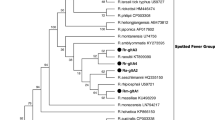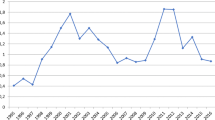Abstract
During an 8-years study, we collected from vegetation or domestic and wild mammals 1246 ticks (624 males, 511 females and 111 nymphs) belonging to 13 species in Jaen province (Andalusia) and we analyzed these ticks by PCR and sequencing for the presence of rickettsiae. Specific rickettsiae DNA was detected in 243 (19.5%) of the ticks tested. Sequence analysis of amplicons of gltA, ompA and ompB genes revealed that Ixodes ricinus were infected with R. monacensis, including strain IRS3, and R. helvetica (prevalences of 27.0% and 2.7%, respectively), while in I. ventalloi we found only this last species (12.5%). Moreover, Dermacentor marginatus presents R. slovaca (24.7%) and R. raoultii (59.9%). In Rhipicephalus sanguineus group ticks (Rh. sanguineus, Rh. turanicus and Rh. pusillus) only R. massiliae (15.2%) was found. Haemaphysalis punctata and Ha. sulcata were infected with a Rickettsia sp. near R. hoogstraalii (prevalence of 3.1% and 16.1%, respectively). In addition, Ha. punctata appeared infected with R. monacensis—like Rickettsia (1.0%) and R. raoultii (9.3%). None of I. hexagonus, Hyalomma lusitanicum, Hyalomma sp., Ha. hispanica or Rh. bursa studied ticks contained rickettsiae.
Similar content being viewed by others
References
Altschul SF, Gish W, Miller W et al (1990) Basic local alignment search tool. J Mol Biol 215:403–410
Azad AF, Beard CB (1998) Rickettsial pathogens and their arthropod vectors. Emerg Infect Dis 4:179–186
Bacellar F (1999) Ticks and spotted fever rickettsiae in Portugal. In: Brouqui DR (ed) Rickettsiae and Rickettsial diseases at the turn of the third millenium. Elsevier, Paris
Bartolomé J, Lorente S, Hernández-Pérez N et al (2005) Estudio clínico-epidemiológico de las rickettsiosis del grupo de las fiebres exantemáticas en Albacete. Enferm Infecc Microbiol Clin 23:194–196. doi:10.1157/13073143
Beati L, Keirans JE (2001) Analysis of the systematic relationships among ticks of the genera Rhipicephalus and Boophilus (Acari: Ixodidae) based on mitochondrial 12S ribosomal DNA gene sequences and morphological characters. J Parasitol 87:32–48
Beati L, Raoult D (1993) Rickettsia massiliae sp. nov., a new spotted fever group Rickettsia. Int J Syst Bacteriol 43:839–840
Beati L, Humair PF, Aeschlimann A et al (1994) Identification of spotted fever group rickettsiae isolated from Dermacentor marginatus and Ixodes ricinus ticks collected in Switzerland. Am J Trop Med Hyg 51:138–148
Beati L, Meskini M, Thiers B et al (1997) Rickettsia aeschlimannii sp. nov., a new spotted fever group rickettsia associated with Hyalomma marginatum ticks. Int J Syst Bacteriol 47:548–554
Beati L, Roux V, Ortuño A et al (1996) Phenotypic and genotypic characterization of spotted fever group Rickettsiae isolated from Catalan Rhipicephalus sanguineus ticks. J Clin Microbiol 34:2688–2694
Bernabeu-Wittel M, del Toro MD, Nogueras MM et al (2005) Presence of human past infections due to the Bar29 rickettsial strain in Southern Spain. J Infect 52:e117–e119. doi:10.1016/j.jinf.2005.07.012
Bernabeu-Wittel M, del Toro MD, Nogueras MM et al (2006) Seroepidemiological study of Rickettsia felis, Rickettsia typhi, and Rickettsia conorii infection among the population of southern Spain. Eur J Clin Microbiol Infect Dis 25:375–381. doi:10.1007/s10096-006-0147-6
Bernasconi MV, Casati S, Peter O et al (2002) Rhipicephalus ticks infected with Rickettsia and Coxiella in Southern Switzerland (Canton Ticino). Infect Genet Evol 2:111–120. doi:10.1016/S1567-1348(02)00092-8
Bitam I, Parola P, Matsumoto K et al (2006) First molecular detection of R. conorii, R. aeschlimannii, and R. massiliae in ticks from Algeria. Ann N Y Acad Sci 1078:368–372. doi:10.1196/annals.1374.073
Brouqui P, Parola P, Fournier PE et al (2007) Spotted fever rickettsioses in southern and eastern Europe. FEMS Immunol Med Microbiol 49:2–12. doi:10.1111/j.1574-695X.2006.00138.x
Cardeñosa N, Segura F, Raoult D (2003) Serosurvey among Mediterranean spotted fever patients of a new spotted fever group rickettsial strain (Bar29). Eur J Epidemiol 18:351–356. doi:10.1023/A:1023654400796
Cardeñosa N, Nogueras MM, Font B et al (2006) Serological evidence of human infection with rickettsial strain Bar29 in Catalonia, northeastern Spain. Eur J Clin Microbiol Infect Dis 25:541–543. doi:10.1007/s10096-006-0176-1
de Sousa R, Barata C, Vitorino L et al (2006a) Rickettsia sibirica isolation from a patient and detection in ticks, Portugal. Emerg Infect Dis 12:1103–1108
de Sousa R, Luz T, Parreira P et al (2006b) Boutonneuse fever and climate variability. Ann N Y Acad Sci 1078:162–169. doi:10.1196/annals.1374.029
Duh D, Punda-Polić V, Trilar T et al (2006) Molecular identification of Rickettsia felis-like bacteria in Haemaphysalis sulcata ticks collected from domestic animals in southern Croatia. Ann N Y Acad Sci 1078:347–351. doi:10.1196/annals.1374.068
Eremeeva ME, Bosserman EA, Demma LJ et al (2006) Isolation and identification of Rickettsia massiliae from Rhipicephalus sanguineus ticks collected in Arizona. Appl Environ Microbiol 72:5569–5577. doi:10.1128/AEM.00122-06
Fernández-Soto P, Encinas-Grandes A, Pérez-Sánchez R (2003) Rickettsia aeschlimannii in Spain: molecular evidence in Hyalomma marginatum and five other tick species that feed on humans. Emerg Infect Dis 9:889–890
Fernández-Soto P, Pérez-Sánchez R, Alamo-Sanz R et al (2006a) Spotted fever group rickettsiae in ticks feeding on humans in northwestern Spain: is Rickettsia conorii vanishing? Ann N Y Acad Sci 1078:331–333. doi:10.1196/annals.1374.063
Fernández-Soto P, Pérez-Sánchez R, Díaz Martín V et al (2006b) Rickettsia massiliae in ticks removed from humans in Castilla y León, Spain. Eur J Clin Microbiol Infect Dis 25:811–813. doi:10.1007/s10096-006-0217-9
Fernández-Soto P, Pérez-Sánchez R, Encinas-Grandes A et al (2004) Detection and identification of Rickettsia helvetica and Rickettsia sp. IRS3/IRS4 in Ixodes ricinus ticks found on humans in Spain. Eur J Clin Microbiol Infect Dis 23:648–649. doi:10.1007/s10096-004-1184-7
Fournier PE, Grunnenberger F, Jaulhac B et al (2000) Evidence of Rickettsia helvetica infection in humans, eastern France. Emerg Infect Dis 6:389–392
Gil-Collado J, Guillén-Lera JL, Zapatero-Ramos LM (1979) Claves para la identificación de los Ixodoidea españoles (adultos). Rev Iber Parasitol 39:107–118
Gillespie JJ, Beier MS, Rahman MS et al (2007) Plasmids and rickettsial evolution: insight from Rickettsia felis. PLoS One 2:e266. doi:10.1371/journal.pone.0000266
Gillespie JJ, Williams K, Shukla M et al (2008) Rickettsia phylogenomics: unwinding the intricacies of obligate intracellular life. PLoS One 3:e2018. doi:10.1371/journal.pone.0002018
Gilot B, Laforge ML, Pichot J et al (1990) Relationships between the Rhipicephalus sanguineus complex ecology and Mediterranean spotted fever epidemiology in France. Eur J Epidemiol 6:357–362. doi:10.1007/BF00151708
Guerrero A, Gimeno F, Colomina J et al (2006) Low incidence of tick-borne rickettsiosis in a Spanish Mediterranean area. Ann N Y Acad Sci 1078:200–202. doi:10.1196/annals.1374.039
Hall TA (1999) BioEdit: a user-friendly biological sequence alignment editor and analysis program for Windows 95/98/NT. Nucleic Acids Symp Ser 41:95–98
Herrero-Herrero JI, Ruiz-Beltrán R, Martín-Sánchez AM et al (1989) Mediterranean spotted fever in Salamanca, Spain. Epidemiological study in patients and serosurvey in animals and healthy human population. Acta Trop 46:335–350. doi:10.1016/0001-706X(89)90046-6
Iori A, Di Giulio A, De Felici S (2005) Zecche d’Italia. Cringoli Giuseppe editore, Series Mappe Parassitologiche, Napoli
Jado I, Oteo JA, Aldámiz M et al (2007) Rickettsia monacensis and human disease, Spain. Emerg Infect Dis 13:1405–1407
Lakos A, Raoult D (1999) Tick-borne lymphadenopathy (TIBOLA) a Rickettsia slovaca infection? In: Brouqui DR (ed) Rickettsiae and Rickettsial diseases at the turn of the third millenium. Elsevier, Paris
Lledó L, Gegúndez MI, Fernandes N et al (2006) The seroprevalence of human infection with Rickettsia slovaca, in an area of northern Spain. Ann Trop Med Parasitol 100:337–343. doi:10.1179/136485906X105570
Manilla G (1998) Fauna d’Italia. Acari: Ixodida. Edizioni Calderini, Bologna
Márquez FJ, Morel PC, Guiguen C et al (1992) Clé dichotomique des Ixodidae d’Europe. I.—Les larves du genre Ixodes. Acarologia 33:325–330
Márquez FJ, Muniain MA, Soriguer RC et al (1998) Genotypic identification of an undescribed spotted fever group Rickettsia in Ixodes ricinus from southwestern Spain. Am J Trop Med Hyg 58:570–577
Márquez FJ, Rojas A, Ibarra V et al (2006) Prevalence data of Rickettsia slovaca and other SFG rickettsiae species in Dermacentor marginatus in the southeastern Iberian peninsula. Ann N Y Acad Sci 1078:328–330. doi:10.1196/annals.1374.062
Márquez FJ, Rodríguez-Liébana JJ, Soriguer RC et al (2008) Spotted fever group Rickettsia in brown dog ticks Rhipicephalus sanguineus in southwestern Spain. Parasitol Res 103:119–122
Matsumoto K, Parola P, Brouqui P et al (2004) Rickettsia aeschlimannii in Hyalomma ticks from Corsica. Eur J Clin Microbiol Infect Dis 23:732–734. doi:10.1007/s10096-004-1190-9
Mattila JT, Burkhardt NY, Hutcheson HJ et al (2007) Isolation of cell lines and a rickettsial endosymbiont from the soft tick Carios capensis (Acari: Argasidae: Ornithodorinae). J Med Entomol 44:1091–1101. doi:10.1603/0022-2585(2007)44[1091:IOCLAA]2.0.CO;2
Mediannikov O, Matsumoto K, Samoylenko I et al (2008) Rickettsia raoultii sp. nov., a spotted fever group rickettsia associated with Dermacentor ticks in Europe and Russia. Int J Syst Evol Microbiol 58:1635–1639
Merino FJ, Nebreda T, Serrano JL et al (2005) Tick species and tick-borne infections identified in population from a rural area of Spain. Epidemiol Infect 133:943–949. doi:10.1017/S0950268805004061
Oteo JA, Ibarra V, Blanco JR et al (2004) Dermacentor-borne necrosis erythema and lymphadenopathy: clinical and epidemiological features of a new tick-borne disease. Clin Microbiol Infect 10:327–331. doi:10.1111/j.1198-743X.2004.00782.x
Oteo JA, Portillo A, Santibáñez S et al (2006) Cluster of cases of human Rickettsia felis infection from Southern Europe (Spain) diagnosed by PCR. J Clin Microbiol 44:2669–2671. doi:10.1128/JCM.00366-06
Parola P, Paddock CD, Raoult D (2005) Tick-borne rickettsioses around the world: emerging diseases challenging old concepts. Clin Microbiol Rev 18:719–756. doi:10.1128/CMR.18.4.719-756.2005
Psaroulaki A, Ragiadakou D, Kouris G et al (2006) Ticks, tick-borne rickettsiae, and Coxiella burnetii in the Greek Island of Cephalonia. Ann N Y Acad Sci 1078:389–399. doi:10.1196/annals.1374.077
Punda-Polić V, Petrovec M, Trilar T et al (2002) Detection and identification of spotted fever group rickettsiae in ticks collected in southern Croatia. Exp Appl Acarol 28:169–176. doi:10.1023/A:1025334113190
Radulovic S, Feng HM, Morovic M et al (1996) Isolation of Rickettsia akari from a patient in a region where Mediterranean spotted fever is endemic. Clin Infect Dis 22:216–220
Raoult D, Roux V (1997) Rickettsioses as paradigms of new or emerging infectious diseases. Clin Microbiol Rev 10:694–719
Raoult D, Berbis P, Roux V et al (1997) A new tick-transmitted disease due to Rickettsia slovaca. Lancet 350:112–113. doi:10.1016/S0140-6736(05)61814-4
Raoult D, Fournier PE, Abboud P et al (2002) First documented human Rickettsia aeschlimannii infection. Emerg Infect Dis 8:748–749
Rehácek J, Tarasevich IV (1991) Ecological questions concerning rickettsiae. Eur J Epidemiol 7:229–236. doi:10.1007/BF00145671
Salvador A, Veiga JP, Civantos E (1999) Do skin pockets of lizards reduce the deleterious effects of ectoparasites? An experimental study with Psammodromus algirus. Herpetologica 55:1–7
Santos-Silva M, Sousa R, Santos AS et al (2006) Ticks and tick-borne rickettsiae surveillance in Montesinho Natural Park, Portugal. Ann N Y Acad Sci 1078:137–142. doi:10.1196/annals.1374.023
Sekeyova Z, Roux V, Xu W et al (1998) Rickettsia slovaca sp. nov., a member of the spotted fever group rickettisae. Int J Syst Bacteriol 48:1455–1462
Sekeyova Z, Roux V, Raoult D (2001) Phylogeny of Rickettsia spp. inferred by comparing sequences of ‘gene D’, which encodes an intracytoplasmic protein. Int J Syst Evol Microbiol 51:1353–1360
Shpynov S, Parola P, Rudakov N et al (2001) Detection and identification of spotted fever group rickettsiae in Dermacentor ticks from Russia and central Kazakhstan. Eur J Clin Microbiol Infect Dis 20:903–905. doi:10.1007/s10096-001-0638-4
Simser JA, Palmer AT, Fingerle V et al (2002) Rickettsia monacensis sp. nov., a spotted fever group Rickettsia, from ticks (Ixodes ricinus) collected in a European city park. Appl Environ Microbiol 68:4559–4566. doi:10.1128/AEM.68.9.4559-4566.2002
Stothard DR, Clark JB, Fuerst PA (1994) Ancestral divergence of Rickettsia bellii from the spotted fever and typhus groups of Rickettsia and antiquity of the genus Rickettsia. Int J Syst Bacteriol 44:798–804
Vitale G, Mansuelo S, Rolain JM et al (2006) Rickettsia massiliae human isolation. Emerg Infect Dis 12:174–175
Walker DH, Fishbein DB (1991) Epidemiology of rickettsial diseases. Eur J Epidemiol 7:237–245. doi:10.1007/BF00145672
Walker JB, Keirans JE, Horak IG (2000) The genus Rhipicephalus (Acari, Ixodoidea). A guide to the Brown Ticks of the World. Cambridge University Press, Cambridge
Zhu Y, Fournier PE, Eremeeva M et al (2005) Proposal to create subspecies of Rickettsia conorii based on multi-locus sequence typing and an emended description of Rickettsia conorii. BMC Microbiol 5:11. doi:10.1186/1471-2180-5-11
Acknowledgments
We thank Javier Millán for his suggestions and comments on preparing the manuscript. We are grateful to Antonio Hidalgo, Damián J. Galán, Samer Alasaad, Pilar Simón and José Luis Rodríguez for their help collecting ticks. Financial support was provided by the Fondo de Investigación Sanitaria program, Ministerio de Sanidad y Consumo, Spain (grant 04–1521).
Author information
Authors and Affiliations
Corresponding author
Rights and permissions
About this article
Cite this article
Márquez, F.J. Spotted fever group Rickettsia in ticks from southeastern Spain natural parks. Exp Appl Acarol 45, 185–194 (2008). https://doi.org/10.1007/s10493-008-9181-7
Received:
Accepted:
Published:
Issue Date:
DOI: https://doi.org/10.1007/s10493-008-9181-7




